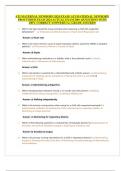Exam (elaborations)
ATI MATERNAL NEWBORN 2024 EXAM/ ATI MATERNAL NEWBORN PROCTORED EXAM 2024 ACTUAL EXAM 200+ QUESTIONS WITH 100% CORRECT ANSWERS /A+ GRADE ASSURED
- Course
- Institution
ATI MATERNAL NEWBORN 2024 EXAM/ ATI MATERNAL NEWBORN PROCTORED EXAM 2024 ACTUAL EXAM 200+ QUESTIONS WITH 100% CORRECT ANSWERS /A+ GRADE ASSURED
[Show more]



